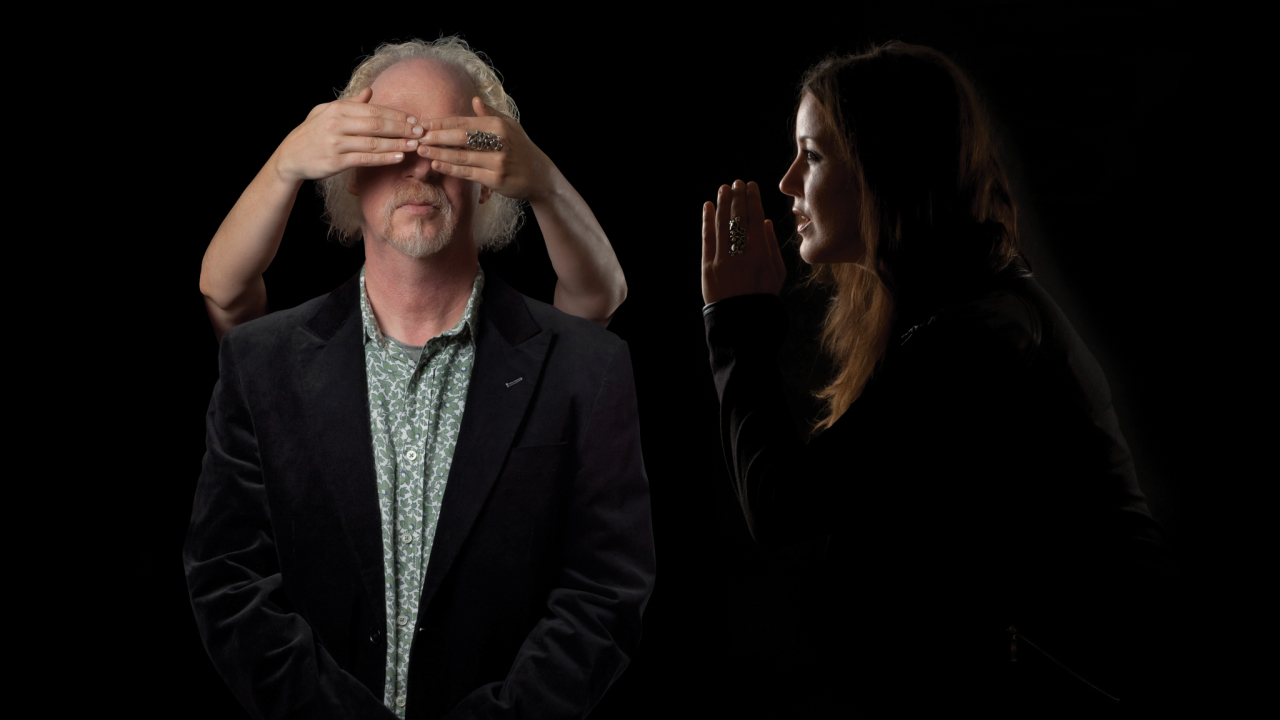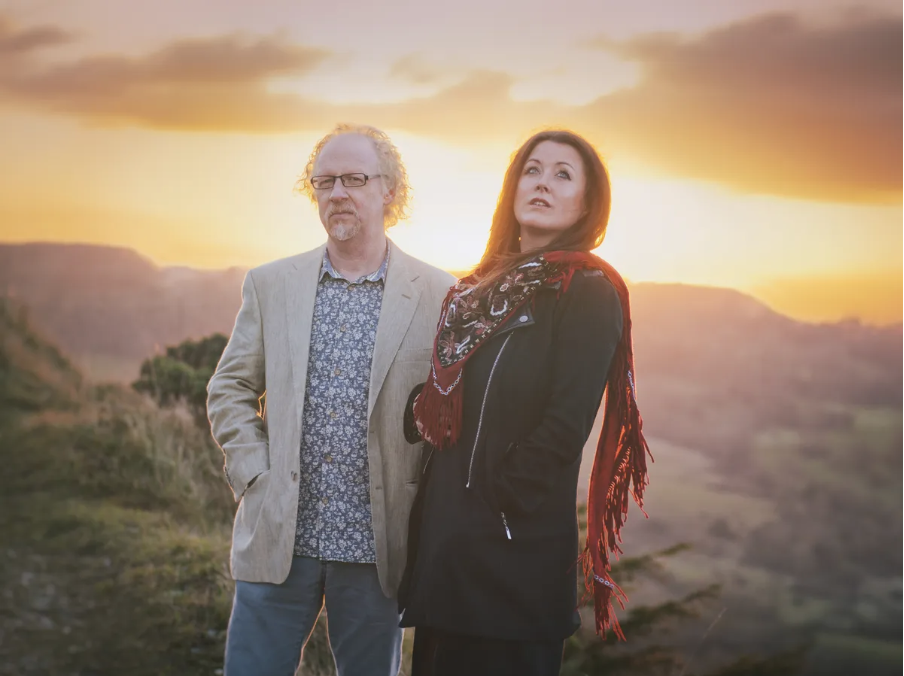"The idea was to try a purely acoustic album for ideas that aren’t Panic Room and see how it goes.” The evolution of acoustic prog duo Luna Rossa
The elegant sounds of Luna Rossa have turned the project into a big success for Panic Room duo Anne-Marie Helder and Jonathan Edwards. We get the inside story behind their second release.

To call Luna Rossa a side project is to damn it with unjustly faint praise. Let’s try “exciting musical alter ego” for starters, and then see where Anne-Marie Helder and Jonathan Edwards take us.
The acoustic persona of the duo from Welsh prog stalwarts Panic Room laid down a distinct identity of their own with Luna Rossa’s 2013 debut Sleeping Pills & Lullabies. Less than 18 months later, they’ve doubled their money. Secrets & Lies was released in November 2014 and already stands tall among the most inventive and sophisticated unplugged albums of recent vintage. Not bad for a couple of musicians who don’t mind admitting they were shooting in the dark when they decided to give themselves a second creative outlet.
“With the first album, we didn’t really know what we were doing,” says Edwards disarmingly when the three of us sit down in a London hostelry. “All we knew was that we wanted to do something we liked.”
The duo’s first album was recorded a couple of years before it was released, as the new endeavour came gradually into focus – not least since deciding on a name took more than a while. “We’d been making lots of lists, then one morning I just woke up with ‘Luna Rossa’ in my head,” says Helder. “I know Italian to a certain degree anyway, and I like the moon and I like red. It also means the fans can call themselves Lunies, which we quite like. We’ve got Roomies for Panic Room.”
Teasing out the slightly different sensibilities of the Luna Rossa sound, with its elegant tints of folk, pop and even classical, makes sense for lots of reasons. “I think we’ve both got quite acoustic sensibilities, we always have had, and I’ve done a lot of solo acoustic work,” says Helder. “So while there are some tracks with Panic Room which are like that in nature, it’s good to vary the set. It was Jon’s idea, really, to try a purely acoustic album for ideas that aren’t Panic Room and see how it goes.”
The answer, with Sleeping Pills & Lullabies, was extremely well. Hence the swift follow-up and a real feeling of unforced momentum, and the fact that the two bands can draw on each other’s energy.
“People say, ‘With you doing an acoustic album with Luna Rossa, does it mean Panic Room will get more acoustic?’” Helder goes on. “In some ways, I think it’s the opposite, because we can do exactly what we want with Panic Room. If anything, the next [Panic Room] album will probably be heavier. Diversifying is the key, and most musicians we know are busy with a lot of projects – it’s not just us.”
Sign up below to get the latest from Prog, plus exclusive special offers, direct to your inbox!
The hugely positive reaction to the new sophomore album has already helped the pair to bed down the very reasoning behind the band’s existence. “When they knew we were releasing the first Luna Rossa album, some people, especially press, were thinking, ‘Is it going to be Panic Room lite?’” Helder says. “Whereas I think now we’ve had both the first and second album out, they realise it’s very different. There’s power in both.”
Issues of time management are always present, but never threatening. “It does dovetail quite well,” Helder reveals, “because with Jon and I being the main writers for both projects, we know when we’re going to be busy, so it’s just a case of planning it. Panic Room’s a five-piece, so everyone’s involved. To be honest, it is a full-time job just being Panic Room, so we have to clone ourselves sometimes. But the other guys have other projects, and lives and families. We’ve managed to fit it together, although we only did a few Luna Rossa shows in 2014.”
Edwards agrees, adding: “The only people we have to work around are ourselves.”

The pair met at the turn of the century, when Edwards was playing in the original line-up of Welsh prog mainstays Karnataka. Ask nicely, and he’ll also admit to his time in the Led Zeppelin tribute band Easily Led. He didn’t play bass, and his colleague didn’t play keyboards, so they were both John Paul Jones.
Back to Karnataka: when they were about to film a concert for DVD release, they remembered how impressed they’d been with Helder’s performances in and around Swansea with Tiger Dragon and as a backing vocalist elsewhere, and asked her to take part.
“We carried on working until that band… finished, that’s the best word for it,” laughs Helder. “Back in those days, Jon and I didn’t write together; I was writing my own stuff, and went on to do lots of solo touring of my own. It was only in 2006-ish that we started writing.”
With fellow Karnataka members Gavin Griffiths and Paul Davies still on board, and the addition of then-bassist Alun Vaughan, Panic Room were born. “It just seemed like a really good opportunity to have a band that Anne was at the front of,” says Edwards.
But as that group rose through the ranks to command great respect for its four-album catalogue, the opportunity for Edwards and Helder to be musically bilingual was presenting itself — even if it took a while to find the best way of working together as a duo.
“In the beginning, I found it much more of a challenge to co-write with Jon because I’d written on my own for so long, working solo a lot and fronting things, and it was my writing,” Helder explains. “It’s a new skill to learn, and I found the more you practise, the better you get.”
“We never sat down and said, ‘What music do we have in common?’” says Edwards. “You discover what you like as you go along. You’ll put something in a song and Anne will say, ‘That’s very Nick Drake‑ish,’ and you think, ‘Oh yeah, it’s meant to be.’ We haven’t had a conversation about sounding like him, but there’s a cello line and she’ll recognise it.”
“We’ve also both grown up liking so many different styles of music,” says Helder. “Both of us have experience of classical music, and I certainly grew up around it, so maybe that informs my writing more than I realise. Even if Jon sends me something which is essentially just a groove, I’ll quite quickly find a melody that I can hear in my head first and think, ‘Let’s follow that as a vocal or an instrumental line.’ Even the biggest classical works have a strong sense of melody.”
The success of both Luna Rossa albums lies in how distinctive they sound, while still complementing the band they grew out of. “We didn’t set out to make the arrangements simpler or more difficult,” Helder points out. “In some ways, we wanted the songs on this album to be as short and to the point as possible. I think it’s a real skill: it hones your songwriting. It’s relatively easy to make an eight- or 10-minute song ramble on, but it’s nice to keep things short and condensed.
“Not just as musicians but as people, we all have different spheres of ourselves. There’s a part of me that loves to play acoustic and quiet, but there’s also the part that loves to rock and go crazy. Hopefully,” she laughs, “you get the right mood for the right gig.”
One of the many pleasant surprises of Secrets & Lies is in its two covers, of Tiny Demons, from Todd Rundgren’s Healing album, and Randy Newman’s early pop ballad triumph I’ve Been Wrong Before, a hit for Cilla Black that Dusty Springfield also interpreted. Edwards knew the latter composition not from either 1960s cover, but from Elvis Costello’s later reading. “I bought [Costello’s 1995 album] Kojak Variety and I loved the song, so I bought the Dusty album with it on,” he says.
“When Jon first gave me the Dusty version, it was really daunting,” admits Helder. “It’s Dusty Springfield, what can you do? It’s not a case of bettering it, it’s just doing it in our style.”
“I like the idea that if you’re going to do a cover, it should be a song that means something to you,” says Edwards. “We could do Solsbury Hill and everybody would know it, but that song means something to me, and so does the Todd Rundgren song.”
That remake was even more of a challenge for Helder, because she knew that both Edwards and Luna Rossa engineer Tim Hamill were aficionados. “I got even more daunted, not only covering it but because I’ve got these two guys who are huge fans, and how was I going to do it as a female voice? But I think people know we’re open to quirky ideas, so us doing Tiny Demons wasn’t a stretch.”
As for the notion that this is a battle of the bands and that one will eventually outlive the other, the duo have other ideas. “In a way,” says Edwards, “it’s like asking a parent, ‘Which is your favourite child?’”
“I love the fact that both bands coexist,” adds Helder. “I’ve never thought Luna Rossa would eclipse Panic Room. I’m like a proud mum. For years, Panic Room has come first, so Luna Rossa is like its little sister, and I think there’s space for both.”
Secrets & Lies is out now on Nova. See www.lunarossa.co for more info.
Prog Magazine contributor Paul Sexton is a London-based journalist, broadcaster and author who started writing for the national UK music press while still at school in 1977. He has written for all of the British quality press, most regularly for The Times and Sunday Times, as well as for Radio Times, Billboard, Music Week and many others. Sexton has made countless documentaries and shows for BBC Radio 2 and inflight programming for such airlines as Virgin Atlantic and Cathay Pacific. He contributes to Universal's uDiscoverMusic site and has compiled numerous sleeve notes for the Rolling Stones, Eric Clapton and other major artists. He is the author of Prince: A Portrait of the Artist in Memories & Memorabilia and, in rare moments away from music, supports his local Sutton United FC and, inexplicably, Crewe Alexandra FC.

